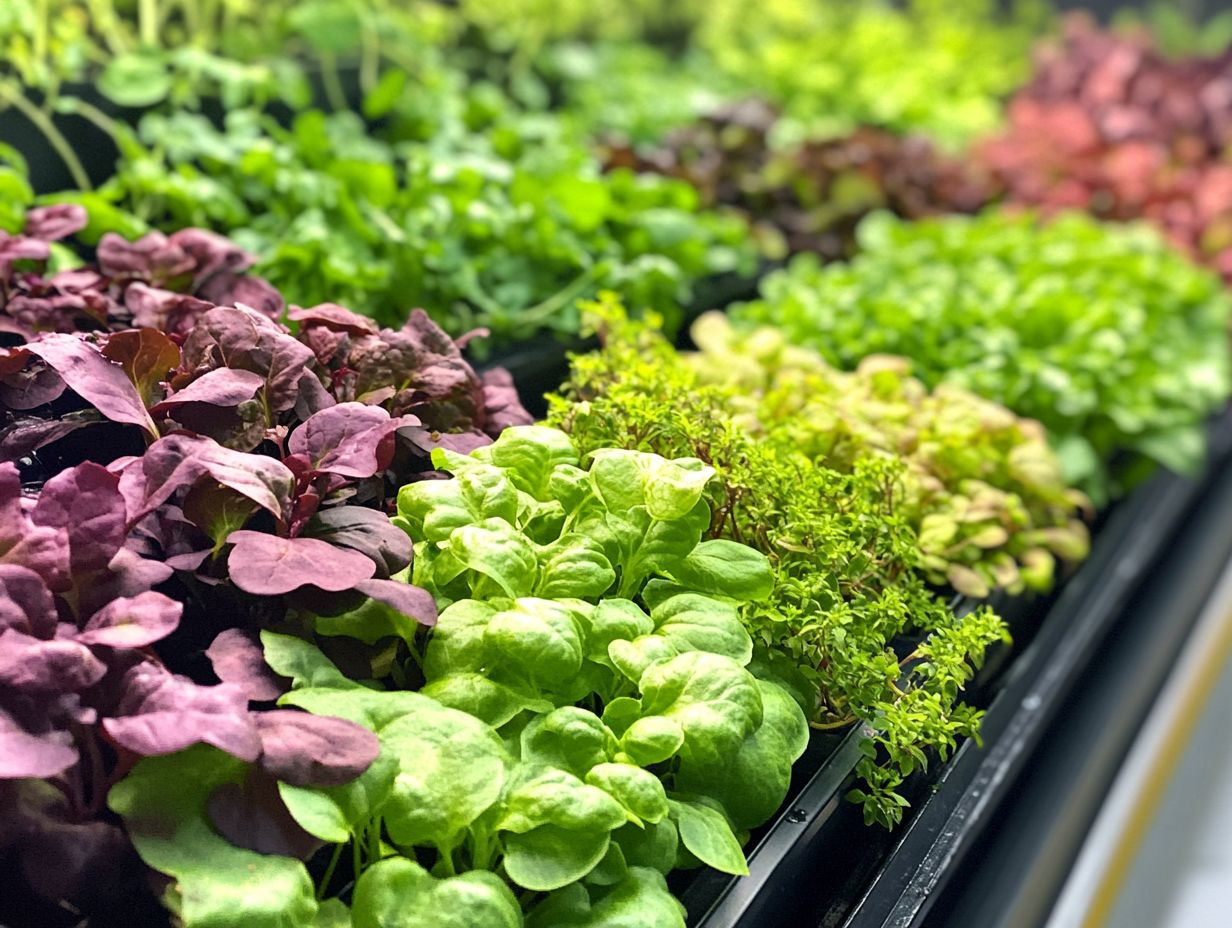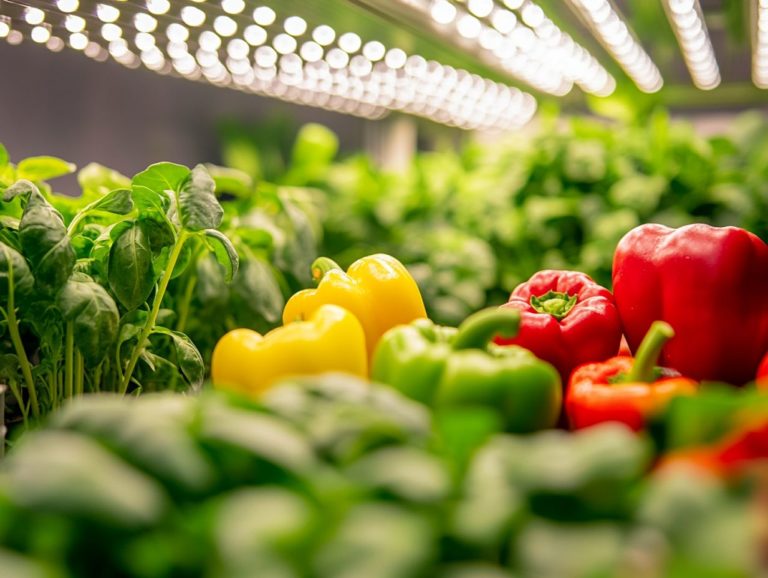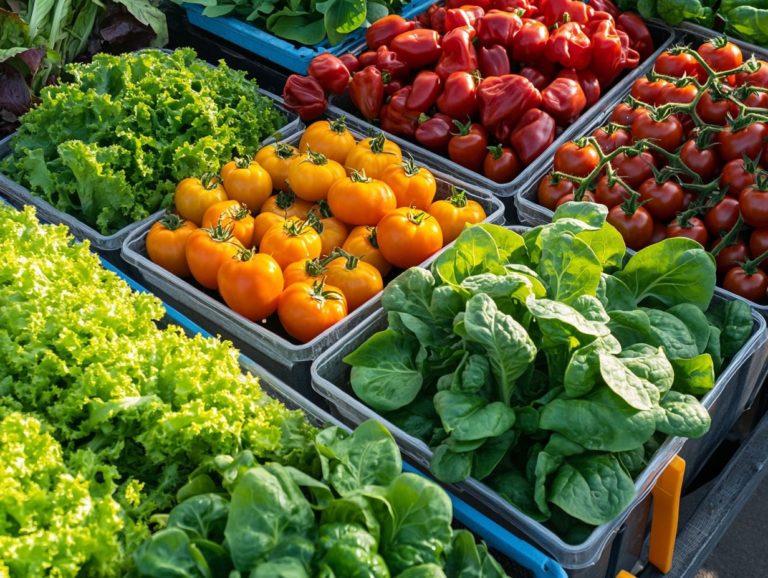“Best Hydroponic Plants for Nutrient-Rich Harvests”
Hydroponic gardening, also known as hydroponic farming, is revolutionizing the way you grow food. It provides a soil-less environment that maximizes yields while conserving both space and resources.
Explore the myriad benefits of hydroponic gardening, from bountiful, nutrient-rich harvests to optimal conditions for diverse produce usage.
Get ready to dive into the world of hydroponic gardening! This guide will help you select the best plants, explore innovative options, set up your very own hydroponic system, and ensure its maintenance for ongoing success.
Whether you’re just starting out or aiming to elevate your gardening skills with health benefits in mind, this guide offers valuable insights for everyone!
Contents
- Key Takeaways:
- What is Hydroponic Gardening?
- Benefits of Hydroponic Gardening
- Choosing the Right Plants for Hydroponic Gardening
- Setting Up a Hydroponic System
- Tips for Maintaining a Successful Hydroponic Garden
- Frequently Asked Questions
- What are the benefits of growing hydroponic plants for nutrient-rich harvests and their health benefits?
- What are the best hydroponic plants for nutrient-rich harvests and some popular choices?
- Is it difficult to maintain the nutrient levels in a hydroponic system, especially regarding nutrient management?
- Do hydroponic plants require any special equipment to maximize growing conditions?
- What is the best type of hydroponic system for nutrient-rich plant growth, considering various innovative selections?
- Can I grow non-edible plants using hydroponics for nutrient-rich results and explore their unique flavor profiles?
Key Takeaways:

- Hydroponic gardening allows for efficient and space-saving cultivation of nutrient-rich plants.
- When choosing plants, consider growth rate, root structure, and nutrient needs.
- Proper nutrient levels and pH balance are crucial for success. Avoid over or under-fertilizing to ensure a bountiful harvest.
What is Hydroponic Gardening?
Hydroponic gardening is an innovative agricultural method that allows you to grow plants without soil. It utilizes nutrient-rich water and advanced solutions to provide essential elements for growth.
This technique optimizes growing conditions, enabling you, whether a health-conscious consumer, culinary enthusiast, or diverse foodie, to enjoy fresh produce year-round, free from seasonal limitations.
By integrating hydroponic systems, you can achieve high-quality produce while minimizing environmental impact through the efficient use of water and resources.
The core principle of hydroponic gardening is delivering precise nutrient solutions directly to plant roots. This ensures they receive the perfect blend of vitamins and minerals needed for robust growth while enhancing flavors.
Various techniques cater to different plant species, such as nutrient film technique (NFT), where plants grow in a shallow stream of nutrient-rich water, or deep water culture (DWC), where roots float in a nutrient solution.
This adaptability fosters impressive diversity in hydroponic plants and helps tackle challenges that traditional farming encounters, such as soil erosion, pest-related issues, and the need to reduce pesticides.
By creating a controlled environment, hydroponics promotes healthier plants and enhances yield potential, making it a sustainable option for modern agricultural endeavors.
Benefits of Hydroponic Gardening
Hydroponic gardening presents a wealth of advantages, positioning itself as a sustainable choice for cultivating healthy, nutrient-dense plants while significantly reducing environmental impact, especially in the local market.
This method allows you enhanced control over growing conditions, cutting down on pesticide usage while elevating health benefits for those who demand high-quality produce with unique flavors.
Hydroponic systems allow you to grow a wide variety of crops, from crisp leafy greens to aromatic herbs like basil and cilantro, all within optimal conditions that traditional soil-based gardening simply can t match.
Nutrient-Rich Harvests
Hydroponic gardening produces nutrient-rich harvests that are not only visually stunning but also brimming with antioxidants and essential nutrients. This makes them popular choices among health-conscious consumers.
Imagine vibrant leafy greens like kale, spinach, and arugula, alongside flavorful herbs such as basil and cilantro. These plants flourish in precisely managed liquids that provide them with the nutrients they need to grow.
This method opens up exciting culinary possibilities that elevate flavors. Hydroponic produce is an ideal choice for discerning food enthusiasts who seek quality ingredients and unique culinary pairings.
The absence of soil accelerates growth cycles and reduces pest risks. This contributes directly to higher nutrient density and showcases the vibrant colors found in hydroponic produce.
Take hydroponically grown tomatoes, for example they offer a luscious, juicy flavor and sweet taste along with a remarkable dose of lycopene, a powerful antioxidant.
You can incorporate these crops into a variety of dishes, from colorful salads brimming with mixed greens and herbs to fresh pesto crafted from hydroponic basil. This showcases the versatility of hydroponic plants.
As chefs and home cooks increasingly embrace the advantages of hydroponic produce, the demand for these flavorful, nutrient-packed options continues to rise. This is transforming the landscape of healthy eating and enhancing flavors in dishes.
Efficiency and Space-Saving
Hydroponic gardening is an exciting way to grow your favorite plants efficiently! It allows you to maximize space through vertical farming techniques and effectively reduce water use.
This method enables you to cultivate a diverse array of fresh produce, including easy-to-grow crops, even in limited areas. By opting for a soil-less environment, you can achieve higher yields per square foot compared to traditional farming methods.
With controlled greenhouse conditions, you can fine-tune factors like light, temperature, and nutrient delivery to optimize plant growth while ensuring nutrient management is at its best.
This innovative approach conserves precious land resources and significantly reduces water usage. Hydroponics is a sustainable option compared to conventional agriculture.
With vertical farming setups, you can stack layers of crops. This enhances their access to sunlight and promotes efficient growth cycles that maximize nutrient uptake.
Integrating greenhouse setups allows for year-round production. Climate control technologies protect your crops from adverse weather conditions and pests, which is crucial for reducing the need for pesticides.
Ultimately, this combination leads to increased productivity and a consistent supply of high-quality produce that meets the growing demands of urban consumers and diverse foodies.
Choosing the Right Plants for Hydroponic Gardening

Selecting the right plants for hydroponic gardening is essential for achieving successful growth and optimal yields. Consider their specific nutrient requirements as well as market trends emphasizing organic options.
Additionally, align your choices with what s popular among fellow growers. The versatility of hydroponic systems opens the door to a wide variety of crops.
From easy-to-grow leafy greens like collard greens and romaine to flavorful herbs, these are perfectly suited for diverse culinary applications and enhancing flavors in meals.
By understanding the unique characteristics of each plant, you can elevate your hydroponic gardening experience. This truly caters to your health-conscious lifestyle and allows you to enjoy the health benefits of nutrient-rich produce.
Don t miss out on the chance to grow the freshest, healthiest produce right in your home!
Factors to Consider
Selecting plants for hydroponic gardening requires attention to several factors. Focus on growing conditions and how to provide the right food for your plants to ensure optimal growth.
Each plant has its own nutrient needs. Understanding these can enhance health benefits and eliminate the seasonal limitations of soil-based gardening.
For example, flavorful herbs like thyme and rosemary flourish in the ideal conditions hydroponic systems provide. They show how versatile they can be in cooking.
The growth environment is crucial. You need to adjust factors like temperature, light, and humidity for the specific plants you choose.
Market trends also play a role in your selections. With rising consumer demand for organic and nutrient-dense produce, consider innovative options for your hydroponic garden.
Combining these elements wisely can lead to a successful yield. This approach not only promotes health benefits from your crops but enhances your dietary choices.
Top Nutrient-Rich Plants for Hydroponic Gardening
Leafy greens like kale, spinach, and romaine are among the top nutrient-rich plants for your hydroponic garden. These choices excel in nutrient uptake and offer impressive health benefits.
You can also grow delicious fruits like strawberries and tomatoes. They thrive in nutrient-rich environments, adding sweetness and savory delight to your meals.
These leafy greens do more than just add color; they’re packed with essential vitamins and minerals. For instance, kale is rich in vitamins A, C, and K, making it a fantastic addition to salads and smoothies.
Spinach is known for its high iron content, elevating any dish think omelets or pasta. Meanwhile, romaine provides a satisfying crunch in wraps and burgers.
Fruits like strawberries bring a burst of flavor to desserts and salads. Tomatoes shine in sauces, salsas, and salads, showing just how versatile hydroponic produce can be.
Setting Up a Hydroponic System
Setting up a hydroponic system requires careful planning and the right equipment. This helps create an environment that supports strong plant growth and healthy roots.
Key components include nutrient solutions for essential nutrients. You also need systems that maintain optimal oxygen levels for root health.
By choosing high-quality materials, you can elevate your hydroponic gardening and harvest exceptional produce that health-conscious consumers will love.
Equipment and Supplies Needed
To establish a successful hydroponic system, you ll need several essential pieces of equipment and supplies, including nutrient solutions, growing mediums, and appropriate lighting setups. A well-balanced nutrient solution is vital for promoting healthy plant growth.
Choosing the right growing medium ensures proper water retention and aeration. Maintaining optimal pH balance is crucial for supporting nutrient uptake and preventing deficiencies in your hydroponic plants.
These components are foundational to your system. An efficient pump system plays a pivotal role by circulating water and nutrients throughout your setup, ensuring that each plant receives the resources it needs. High-quality grow lights are also essential; they mimic natural sunlight and optimize photosynthesis, regardless of the weather outside. Utilizing timers can automate your light cycles, promoting consistent growth while cutting down on energy usage.
Investing in pH and EC meters allows you to monitor the nutrient solution and make necessary adjustments, which is key for preventing stress in plants and ensuring robust yields. Each of these elements works in harmony with the others, creating an environment that fosters thriving hydroponic gardens.
Step-by-Step Guide to Setting Up

Setting up a hydroponic system is an art that unfolds in several critical stages: planning, assembly, and ongoing monitoring to create optimal growing conditions. Start by selecting the right hydroponic system tailored to your space and the crops you intend to grow.
Then, meticulously assemble the components, ensuring that your managing nutrients and water delivery systems are perfectly configured. This initial selection is the bedrock of a successful growth cycle.
Consider the unique needs of your plants they’re the key to a successful garden! Some flourish in deeper water, while others thrive in a system where a thin film of nutrients flows over plant roots.
Once your system is operational, keep a vigilant eye on environmental factors such as pH levels, water temperature, and lighting conditions. Regular tweaks to your nutrient solutions can have a significant impact on plant health and overall crop yield.
By diligently monitoring these elements, you don t wait monitor these parameters regularly to keep your plants thriving!
Tips for Maintaining a Successful Hydroponic Garden
Maintaining a successful hydroponic garden demands your diligent attention to nutrient levels and pH balance, as these elements are crucial for fostering plant health and ensuring optimal growth. Regularly monitoring these parameters enables you to provide hydroponic plants with the essential nutrients they need while avoiding common pitfalls that could result in deficiencies or less-than-ideal yields.
By embracing best practices, you can cultivate a flourishing hydroponic environment that thrives under your care.
Proper Nutrient Levels and pH Balance
Achieving the right nutrient levels and pH balance is essential for the health and productivity of your hydroponic plants, as these elements directly affect nutrient uptake and overall growth. A well-formulated nutrient solution, tailored specifically to the needs of each crop, plays a vital role in ensuring your plants receive the nourishment they require.
Regular pH testing is equally important, as it helps maintain an optimal growing environment. Utilizing monitoring techniques, such as pH meters and nutrient testing kits, enables you to make informed adjustments.
For optimal results, consider using a balanced nutrient solution with a ratio like 3-1-2 or 5-2-2, delivering essential macronutrients in the right proportions. To keep your pH stable, buffers or pH adjusters like phosphoric acid or potassium hydroxide can be highly effective.
Incorporating regular monitoring practices, such as weekly checks or automated systems, ensures that any fluctuations are addressed promptly, fostering healthier and more robust plant growth.
Take charge of your hydroponic garden today and watch it thrive!
Common Mistakes to Avoid
Avoiding common mistakes in hydroponic gardening is vital for maintaining your plants’ health and achieving high yields. Many of these missteps often arise from inadequate nutrient management or improper pH balance.
By regularly monitoring key parameters, you can prevent issues like nutrient deficiency or toxic buildup. This allows for timely adjustments that create optimal growing conditions.
It s easy for new gardeners to underestimate the importance of consistency in these crucial areas, which can have detrimental effects on plant growth. To sidestep such challenges, it s essential for you to develop a routine for checking pH levels and nutrient strengths. Investing in a reliable pH meter and regularly updating your feeding schedules can greatly improve the health of your plants.
Understanding the specific nutrient requirements for different types of plants will ensure a balanced approach, fostering an environment where your crops can thrive without the fear of nutrient problems.
Frequently Asked Questions
What are the benefits of growing hydroponic plants for nutrient-rich harvests and their health benefits?

Hydroponic plants can grow up to 50% faster than traditional soil-based plants, leading to a higher yield in a shorter amount of time. The controlled environment of hydroponic systems allows for optimal nutrient uptake. This results in highly nutritious harvests.
What are the best hydroponic plants for nutrient-rich harvests and some popular choices?
Some of the best hydroponic plants for nutrient-rich harvests include leafy greens like lettuce and spinach, herbs like basil and cilantro, and vegetables like tomatoes and peppers. These plants have high nutrient requirements and thrive in hydroponic systems.
Is it difficult to maintain the nutrient levels in a hydroponic system, especially regarding nutrient management?
Not at all! In fact, maintaining nutrient levels in a hydroponic system is much easier than in traditional soil-based gardening. Most hydroponic systems come with a nutrient solution that is specifically formulated for optimal plant growth, and it is easy to monitor and adjust the levels as needed.
Do hydroponic plants require any special equipment to maximize growing conditions?
Some hydroponic systems might need special equipment, but you can start with simple household items like mason jars or plastic containers. It is also possible to purchase pre-made hydroponic kits that come with all necessary equipment for easy set-up.
What is the best type of hydroponic system for nutrient-rich plant growth, considering various innovative selections?
The best type of hydroponic system for nutrient-rich plant growth depends on the specific plants you are growing and your level of experience. Some popular options include deep water culture, ebb and flow, and drip systems – each with their own unique advantages and disadvantages.
Can I grow non-edible plants using hydroponics for nutrient-rich results and explore their unique flavor profiles?
Absolutely! While hydroponic gardening is commonly associated with growing food, it can also be used for growing decorative plants and flowers. In fact, many flower growers prefer hydroponics as it allows for precise control over nutrient levels, resulting in vibrant and healthy blooms.
Ready to start your hydroponic garden? Here’s how to get started!
If you have more questions, feel free to ask!






